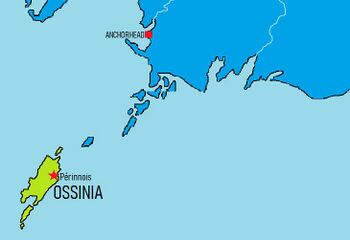Ossinia: Difference between revisions
| Line 123: | Line 123: | ||
Ossinia is of volcanic origin, as evident in its soil, mountainous interior, and several explosion craters, including Lake Antoine, Grand Atang Lake and Letenve Lake. Ossinia's highest point is Mount St. Aberine, rising to 1,840 m (6,036 ft) above sea level. Other major mountains include Mount Granbian and South East Mountain. Several small rivers with waterfalls flow into the sea from these mountains. The coastline contains several bays, most notably on the southern coast which is split into numerous thin peninsulas. | Ossinia is of volcanic origin, as evident in its soil, mountainous interior, and several explosion craters, including Lake Antoine, Grand Atang Lake and Letenve Lake. Ossinia's highest point is Mount St. Aberine, rising to 1,840 m (6,036 ft) above sea level. Other major mountains include Mount Granbian and South East Mountain. Several small rivers with waterfalls flow into the sea from these mountains. The coastline contains several bays, most notably on the southern coast which is split into numerous thin peninsulas. | ||
[[File: | [[File:Perinnoisskyline.jpg|thumb|center|800px|The capital [[Périnnois]] at dusk]] | ||
===Climate=== | ===Climate=== | ||
Revision as of 04:45, 15 May 2020
Federation of Ossinia | |
|---|---|
|
Flag | |
 | |
| Capital | Périnnois |
| Recognised national languages | Ossinian-french |
| Government | |
| Martin Saint-Yves | |
| Population | |
• 2020 estimate | 7,233,000 |
| Date format | mm-dd-yyyy |
The Federation of Ossinia, most commonly known as Ossinia, is an island nation in the Coalition of Crown Albatross located in the Toyana Ocean off the coast of the Province of Alenchon, Zamastan. It is one of the oldest civilizations on Iearth, being continuously habited and largely isolated from the world due to its geographical location since the fifth century B.C.E.. It is largely known for its tropical landscape and beauty, as well as a rich culture.
Once a colony of Skith, it achieved independence in 1903. In 1983, a radical socialist uprising led by Jacob Plantier overthrew the government and installed a dictatorship. The current regime, led by Martin Saint-Yves, has been accused of human rights violations such as frequent executions of citizens and political prisoners, torture, and massive censorship.
History
Pre-colonial history
Ossinia was first populated by peoples from South-western Euronia. The earliest potential human presence comes from proxy evidence of lake cores, beginning ~3600 BC. Less ephemeral, permanent villages began around ~AD 300. The population peaked between AD 750-1250, with major changes in population afterwards, potentially the result of regional droughts and a Quetanan explorer's discovery, although the latter rests on highly circumstantial evidence.
Skith colony (1649–1903)
In 1649 a Skith expedition of 203 men originating from the colony in San Beausoleil, Rio Palito, led by Jacques Parquet founded a permanent settlement on Ossinia. The Skithans signed a peace treaty with the Ossirian Chief Oairouane, but within months conflict broke out between the two communities. This lasted until 1654 when the island was completely subjugated by the Skithans. The indigenous peoples who survived either left for neighbouring islands or retreated to remoter parts of Ossinia, where they ultimately disappeared during the 1700s. Warfare continued during the 1600s between the Skithans on Ossinia and the native population of the other islands in the region.
The Skithans named their new colony La Ossinian, and the economy was initially based on sugar cane and indigo, worked by slaves. The Ossinians established a capital known as Fort Royal (later St. Georgeo's). To shelter from hurricanes the Skith navy would often take refuge in Périnnois' natural harbour, as no nearby Skithan islands had a natural harbour to compare with that of Fort Royal. A renegade army of Zamastanian rebels captured Ossinia during the Revolution of 1804, but were ultimately kicked off the island due to their small numbers being overwhelmed.

Post-independence

In 1903, Ossinia was granted independence as the Skith Empire began to retract from economic decline. Theohilus D. Barryshoe founded the Ossinia Government Association (OGA) in 1917 to agitate for a new and participative constitutional dispensation for the Ossinian people. Partly as a result of Barryshoe's lobbying, Ossinians were granted the right to elect five of the 15 members of the Legislative Council. Barryshow was elected President of Ossinia in 1918. He remained in office until his death in 1952 at the age of 87.
In 1951, Erico Gaierry founded the Ossinia United Labour Party (OULP), initially as a trade union, which led the 1951 general strike for better working conditions. This sparked great unrest—so many buildings were set ablaze that the disturbances became known as the "red sky" days—and the authorities decided to call in military reinforcements to help regain control of the situation. On 10 October 1952, Ossinia held its first general elections on the basis of universal adult suffrage, with Gaierry's party winning six of the eight seats contested. Gaierry was became President in the 1952 election. He remained in office until 1966 when Émile Laframboise was elected President. He lost the 1972 election to Alexis Chappelle, who then lost to Jean-Noël Anouilh in 1980.
Civil conflict gradually broke out between Jean-Noël Anouilh's government and some opposition parties, including the Marxist New Ossinia Movement (NOM) led by Jacob Plantier. Jean-Noël Anouilh and the GULP won the 1980 general election, albeit with an reduced majority; however the opposition deemed the results invalid due to fraud and the violent intimidation performed by the so-called 'Poison Gang', a private militia loyal to Anouilh.
On 1st March 1983, whilst Anouilh was out of the country, the NJM launched a coup which removed Anouilh, suspended the constitution, and established a People's Revolutionary Government (PRG), headed by Plantier who declared himself President. His Marxist–Leninist government established close ties with Yuan, Beleroskov, North Sotoa, and other communist countries. All political parties except for the New Ossinia Movement were banned and no elections were ever held. Jean-Noël Anouilh was granted exile in Zamastan, with President Cassious Castovia cutting off all ties with Plantier's regime.
Plantier died in 1999, with Martin Saint-Yves taking his place. Saint-Yves has been called a dictator by the Zamastanian Intelligence Service, as well as several dozen countries in the C.C.A.. Saint-Yves' regime has been accused of human rights violations such as frequent executions of citizens and political prisoners, torture, and massive censorship.
Geography
The 4 islands of Ossinia are the southernmost islands in the Alenchon archipelago, jutting into the Toyana Ocean, and roughly 140 km (90 mi) south of both Alenchon, a province of Zamastan. Its sister islands make up the southern section of the Ossinian Islands, which include (from north to south) Stéphane, Augustin, Chevalier, and Girardot. Most of the population lives on Augustin, with the largest settlement being the capital of Périnnois.
Ossinia is of volcanic origin, as evident in its soil, mountainous interior, and several explosion craters, including Lake Antoine, Grand Atang Lake and Letenve Lake. Ossinia's highest point is Mount St. Aberine, rising to 1,840 m (6,036 ft) above sea level. Other major mountains include Mount Granbian and South East Mountain. Several small rivers with waterfalls flow into the sea from these mountains. The coastline contains several bays, most notably on the southern coast which is split into numerous thin peninsulas.

Climate
The climate is tropical: hot and humid in the dry season and cooled by the moderate rain fall in the wet season. Ossinia, being on the southern edge of the hurricane belt, has suffered only three hurricanes in fifty years.
Government and Politics
The Federation of Ossinia is one of the world's last remaining socialist countries following the Marxlenist ideology.
Administrative divisions
Ossinia is divided into 15 administrative divisions, or provinces. They are;
1. Stéphane 2. Chapuis
3. Brousseau 4. Hébras
5. Émeric d'El 6. Périnnois (Capital district)
7. Rochette 8. Josette
9. Laffitte 10. Pleimelding
11. Robiquet 12. Beauchamp
13. Bernadettes 14. Rochefort
15. Girardot
Foreign policy
Military
See: Ossinia Revolutionary Armed Forces
As of 2020, Ossinia spent about Z$91.8 million on its armed forces. In 2015, Ossinia devoted more than 10% of its GDP to military expenditures. Ossinia scaled down the numbers of military personnel, from 235,000 in 1994 to about 80,000 in 2013.
Ossinia's military is made up of the Army, Navy, and Air Force. Much of their weaponry was supplied by the Zamastanian Armed Forces in the 1970s, while their more modern equipment is supplied through a few international corporations such as Drambenburgian and Beleroskovian private defense companies. Two destroyers, each armed with approximately 40 long-range missiles and a rail gun, two long-range bombers, and several tanks and helicopters were given to Ossinia in 2016, while massive supplies of small arms come into the country annually. The destroyers were supplied by Habsmarine GmBH, the bombers, tanks, and helicopters supplied by Lakhid Myrtan Luftfahrtverteidigungstechnik GmBH, and the small arms by Wettin Gehwer GmBH; all of which are Drambenburgian contract companies.
Demographics
Culture
Economy
The Ossinian state claims to adhere to socialist principles in organizing its largely state-controlled planned economy. Most of the means of production are owned and run by the government and most of the labor force is employed by the state. Recent years have seen a trend toward more private sector employment. By 2006, public sector employment was 78% and private sector 22%, compared to 91.8% to 8.2% in 1981. Government spending is 78.1% of GDP. Any firm that hires a Ossinian must pay the Ossinian government, which in turn pays the employee in Ossinian pesens. The average monthly wage as of July 2013 is 466 Ossinian pesens—about Z$19.
Ossinia has a dual currency system, whereby most wages and prices are set in Ossinian pesens (OSP), while the tourist economy operates with Convertible pesens (CUC), set at par with the Zamastanian dollar. Every Ossinian household has a ration book (known as libreta) entitling it to a monthly supply of food and other staples, which are provided at nominal cost.
Ossinia's natural resources include sugar, tobacco, fish, citrus fruits, coffee, beans, rice, potatoes, and livestock. Ossinia's most important mineral resource is nickel, with 21% of total exports in 2019.




